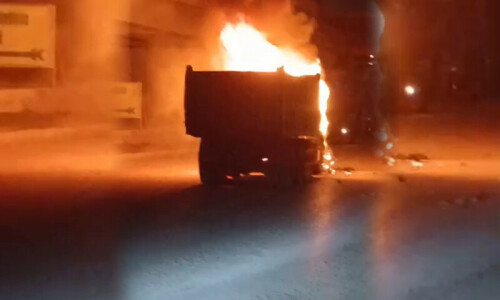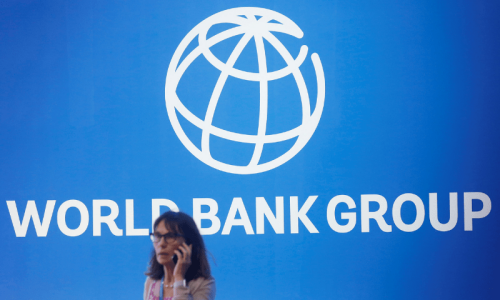THE time to offer Fateha was 3:51pm, precisely the time when the C-130 blew up in mid-air, the bodies of its passengers charred beyond recognition by the time the wreckage hit the ground in Basti Shah Jamal, Bahawalpur district, in south Punjab on that fateful day (Aug 17) in 1988.
Devotees have, however, arrived much earlier from far-flung areas such as Bahawalnagar, Bahawalpur, Nankana Sahib, Dera Ismail Khan, among other regions.
The grave in the centre of the green courtyard of the majestic Shah Faisal Mosque was covered with red rose petals and bouquets. The mausoleum of General Ziaul Haq was covered with green banners carrying his images in military uniform and invitations for the workers to attend the prayers scheduled exactly at 3:51pm, the time of the ‘martyrdom’ of ‘Shaheed-i-Islam’.
One such banner was put up by Ittefaq Group of Developers, Haroonabad, with the familiar slogan ‘Mard-i-Momin Mard-i-Haq, Ziaul Haq, Ziaul Haq’. As the banner flip-flopped in the breeze, for a moment I misread the Ittefaq Group of Developers as Ittefaq Group of Foundries. The foundry flourished during the Zia regime after its owners had faced the wrath of Zia’s predecessor Zulfikar Ali Bhutto, who brought many industries under government control, including those belonging to Mian Mohammad Sharif, father of Mian Mohammad Nawaz Sharif.
Behind the mausoleum around 500 people had gathered under a tent and were listlessly listening to the speakers roaring from behind the microphones and in front of TV cameras. A few passers-by and newlywed couples, who had come to see Faisal mosque, were seen momentarily peeking into the tent then moving on — none bothered to offer Fateha for ‘Shaheed-i-Islam’.
I waited till 3:51pm, hoping that speeches will finish and dua will be offered at the time it had been offered for years. But speeches continued for another hour or so and speakers did not stop praising ‘Shaheed-i-Islam, Shaheed-i-Pakistan and Shaheed-i-Afghanistan’ who, they said, disintegrated the USSR and liberated Central Asia’s Muslim states.
One after the other leaders of Pakistan Muslim League-Zia (PML-Z) took the podium and eulogised General Zia’s ‘services’ for Pakistan, Afghanistan and the Muslim Ummah.
When Ahmed Raza Kasuri, whose father Nawab Mehmood Ahmed Khan Kasuri’s murder was instrumental in Bhutto’s hanging, came to address the gathering, the announcer termed him a ‘sword’ against the PPP.
But Kasuri, in his address, ridiculed Zia’s ‘spiritual son’ and Ijazul Haq’s ‘spiritual brother’ Prime Minister Nawaz Sharif for disowning Zia, who handpicked him as finance minister of Punjab. Thereafter he became Punjab chief minister and eventually got elected as prime minister thrice.
“It’s the duty of the federal government and the Punjab government to commemorate Ziaul Haq’s death anniversary annually because Ziaul Haq has called Nawaz Sharif his ‘spiritual son’ and handed over his legacy to him,” Kasuri said.
“There is no Data Ganj Baksh or Rabia Basri buried in Larkana, but the Sindh government organises annual events to commemorate the birth and death anniversaries of Bhuttos there,” he added.
After his gibe at the Sharifs the announcer issues a warning: “Please avoid raising political matters from this stage.” And Ijazul Haq, the chief of his own PML faction, openly owns militants as his father’s legacy.
“Mujahideen even today love Gen Ziaul Haq and have decorated their camps with his portraits. Because he fought the war of Afghanistan and Pakistan. Today, the US has fled Afghanistan because the true Mujahideen are fighting a true jihad there,” he said.
Though he had announced there is plenty of food in an adjacent tent and the devotees should first offer Fateha at the end of his speech before heading for the meal, the workers rushed to the dining area as soon as he had finished; only a few joined him for the prayer.
“I don’t know how Zia ruled. I only know that Nawaz Sharif is not a good ruler, he is doing nothing to stop floods which destroy our crops every year,” said Bashir Ahmed, 70, who came from Haroonabad in southern Punjab, with his local MPA, a PML-Z member. “I did not come here to attend Zia’s anniversary, I came because my MPA asked me to come,” he said.
Another visitor, Noor Mohammad, 50, who came from Nankana Sahib in a bus arranged by the local PML-Z leader, said he came only to see Islamabad.
Those who have seen Zia’s regime believe the public has no clear memory of the dictator, but there are some who even today believe in and follow his ideology of ‘jihad’.
“I witnessed Zia’s martial law and the years following his death. I have seen thousands of people at his funeral and anniversaries in later years. But the attachment dissipated with the passage of time,” said Mobarik A. Virk, a senior journalist who covered many of Zia’s death anniversaries arranged at the state level when Nawaz Sharif first came to power.
“Today he is remembered by only those who are his actual legacy: the militants talking with guns, inside Pakistan and outside.”
As Ijazul Haq and other leaders leave the mosque, the workers too leave and the white marbled tomb of Zia is once again deserted.
Driving back home, a Facebook status put up a day earlier came to my mind: “How can Hameed Gul die when Gen Zia is still alive and kicking!”
Published in Dawn, August 18th, 2015
On a mobile phone? Get the Dawn Mobile App: Apple Store | Google Play











































